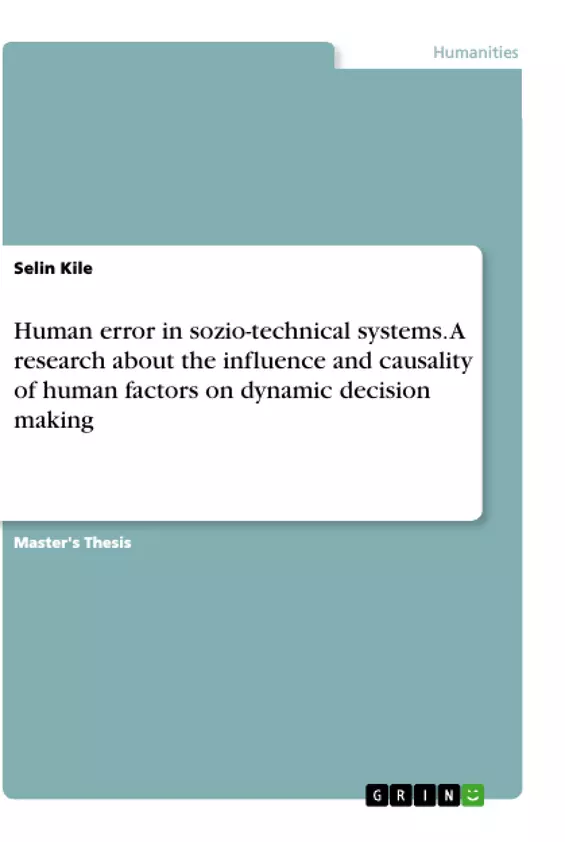The present work addresses human error in socio-technical systems, by considering the influence and causality of human factors on dynamic decision making. The theoretical framework is built by the SHEL-Model from Hawkins (1993). This system-based model illustrates a spectrum of Human Factors (Software, Hardware, Environment, Liveware) and interfaces (Liveware-Software, Liveware-Hardware, Liveware-Environment, Liveware-Liveware) between its elements in socio-technical systems (STS). The model of situation awareness in dynamic decision making from Endsley (1995a) is additionally used to describe the complex decision making process in STS based on the situation awareness (SA), allocated in perception, comprehension and projection and influenced by system and task as well as individual factors.
A study was conducted in a company, producing airconditioning technology with the purpose to investigate and optimize problems related to the usage of company-specific software among the department’s sales and order processing. Additionally the information flow between these departments was examined. In order to specify the problem description from the company itself research questions were formulated within the scope of the mentioned theories: (1) Which SHEL-categories or interfaces should be improved in order to reduce failures and problems in the work within the configuration software? and (2) Which insights of the model of situation awareness should additionally be considered regarding the reduction of failures and problems in the decision making process within the configuration software?
For answering the research questions, first the need for imrprovement was identified within six self-conducted interviews with the sales staff from the outdoor service (n=2), sales staff from the indoor service (n=1), order processing (n=2) and one expert, who was responsible for the sales staff in other countries (n=1). Within Mayring’s (2002, 2010) qualitative data analysis, critical incidents were extracted and related to the SHEL-categories. Additionally categories were inductively builded, based on Endsley’s model.
Inhaltsverzeichnis (Table of Contents)
- Abstract
- Table of content
- List of figures
- List of tables
- List of abbreviations
- 1 Introduction
- 1.1 Company-specific problem description
- 1.2 Framework and content design of this work
- 2 Theoretical framework
- 2.1 SHEL-Model
- 2.1.1 Related concepts and studies
- 2.1.2 Evaluation
- 2.2 Model of SA in dynamic decision making
- 2.2.1 Measurement of SA
- 2.2.2 Related concepts and studies
- 2.2.3 Implications for system design
- 2.2.4 Evaluation
- 2.3 Interfaces between the SHEL-Model and the Model of SA
- 3 Method
- 3.1 Sample
- 3.2 Design and Procedure
- 3.2.1 Diagnosis
- 3.2.2 Scheduling
- 3.2.3 Data collection
- 4 Results
- 4.1 Data editing/preparation
Zielsetzung und Themenschwerpunkte (Objectives and Key Themes)
This master thesis examines human error in socio-technical systems (STS) by exploring the influence and causality of human factors on dynamic decision-making. The study aims to identify specific areas within the STS framework that contribute to errors and to propose solutions for optimizing performance.
- The impact of human factors on decision-making in complex systems
- Analysis of human error within the context of the SHEL-Model
- Application of the situation awareness model in dynamic decision-making
- Investigation of the relationship between automation and human performance
- Practical implications for improving system design and training
Zusammenfassung der Kapitel (Chapter Summaries)
- Chapter 1: Introduction introduces the company-specific problem related to human error in the use of configuration software and outlines the framework and objectives of the thesis.
- Chapter 2: Theoretical framework delves into the SHEL-Model, a system-based model illustrating the interaction of human factors in STS, and the model of situation awareness in dynamic decision-making. It explores the relationship between these models and the implications for system design.
- Chapter 3: Method details the research design and procedure, including the sample selection, data collection methods, and analysis techniques.
- Chapter 4: Results presents the findings of the study, focusing on the identification of critical incidents related to human error and their categorization within the SHEL-Model and the situation awareness model.
Schlüsselwörter (Keywords)
This research focuses on the intersection of socio-technical systems, human factors, dynamic decision-making, situation awareness, automation, usability, and the SHEL-Model. The study investigates the causes and consequences of human error in complex systems and explores practical solutions to optimize performance and reduce failures.
- Arbeit zitieren
- Selin Kile (Autor:in), 2017, Human error in sozio-technical systems. A research about the influence and causality of human factors on dynamic decision making, München, GRIN Verlag, https://www.grin.com/document/1127634



